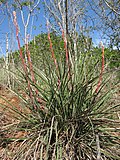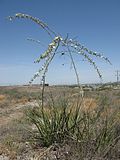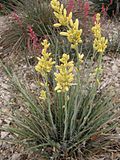| Hesperaloe | |
|---|---|
 | |
| Hesperaloe parviflora | |
| Scientific classification | |
| Kingdom: | Plantae |
| Clade: | Tracheophytes |
| Clade: | Angiosperms |
| Clade: | Monocots |
| Order: | Asparagales |
| Family: | Asparagaceae |
| Subfamily: | Agavoideae |
| Genus: | Hesperaloe Engelm. [1] |
Hesperaloe (false yucca) [2] is a genus of flowering plants in the family Asparagaceae, subfamily Agavoideae. [1] It contains perennial yucca-like plants with long, narrow leaves produced in a basal rosette and flowers borne on long panicles or racemes. The species are native to the arid parts of Texas in the United States and Mexico and are sometimes cultivated as xerophytic ornamental plants. [3]
Contents
The genus name is derived from the Greek word έσπερος (hesperos), meaning "western," and aloe, which the plants resemble. [4] The genus is not closely related to Aloe, the latter belonging to a different family (Asphodelaceae).






